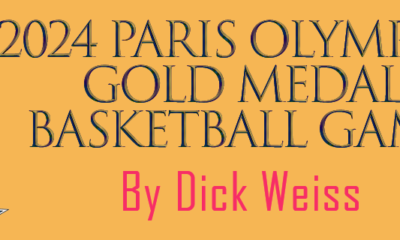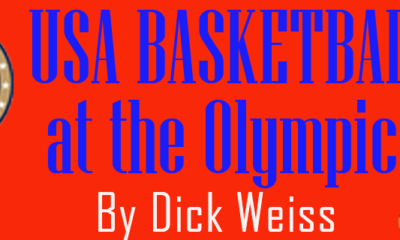
ZARAGOZA, Spain– It was an historic day for Australian women’s basketball.
For the first time ever, the Aussies defeated a U.S. team– which in the past 20 years has been the gold standard in the sport– in international youth competition, defeating the Americans, 73-60, in the semi-finals of the FIBA U 17 world championships here Friday to advance to a spot in the gold medal game against Italy. In the process the Sapphires handed the USA their first ever loss in the FIBA Under 17 Worlds.
This was no fluke. The Sapphires, who have never medaled in this competition, led the entire game and won despite the fact their 6-4 star center Ezi Magbegor fell into serious foul trouble at the start of the second half and eventually fouled out.
The Aussies got a huge game from from 5-9, 16-year old guard Jazmin Shelley from the BA Institute of Sports, who finished with a game high 23 points, 8 rebounds, 5 assists and two steals. She made four of six three point shots. Magbegor, a candidate for MVP in this tournament who finished with 10 points, 10 rebounds. The Aussies scored 23 points off fast breaks.
“I’m stoked, kind of speechless,” she admitted. “First time we’ve ever been to a final. It’s great for the girls.”
Shelley is a country kid from Moe, a small city of 15,000 in Victoria located 80 mils from Melbourne that used to be a way stop on the way to the gold fields. She learned how to play from her parents. “Moe is a good place to live, but not much basketball going around,” Shelley said. My mum and dad both played and so do my brothers. Basketball has always been a big part of my family’s life and we all enjoy it. Now, I definitely have something special to talk about when I go home and we get together.”
Shelley played for the Vic Country Girls and the Rangers growing up, Her team reached the nationals at 14 and she received a scholarship to the Centre for Excellence of Sport in Melbourne, which nurtures promising young prospects. “Nine of the girls there are members of this team,” she said. We lived together and have been playing together for six months.”
Shelley has turned into a versatile player who has a reputation for stepping up in big moments during this tournament on a team that had enough size to match the U.S. and took the Americans out of their game with stifling defense that held 5-10 wing guard Chrystal Williams, the Americans leading scorer, to two points on 1 of 9 shooting and neutralized guard Deshanti Harrison, who needed 21 shots to score 11 points. The U.S. shot just 23 for 75 and made just 1 of 14 three point attempts.
“Defense is a staple of our team,” Australian U 17 coach Shannon Seebohm said. “We’ve been one of the one of the better teams defensively all week.
Anytime you are playing a team as good as the U.S., any advantage you can get is a plus and we felt if we could get out early, they might not have experienced that too often.”
The loss was a shock to the system for the Americans.
“I think we started out slow,” said 6-4 center Olivia Nelson-Ododa, who led Team USA with 17 points and 10 rebounds. The U.S. fell behind 36-27 and half and the Aussies expanded their lead to 59-46 at the end of three quarters.
“We didn’t come out with enough intensity,” said 6-2 forward Aquila DeCosta, who had 12 points, 8 rebounds and 4 blocks. “Once we picked up, it was too late.”
This is the second year the U.S. will leave international age group competition without a gold medal. They lost to Brazil last year in the semi-finals of the U 16 Tournament of Americas zone qualifier last summer. And they could never get closer than 10 in the fourth quarter against Australia. It is hard to come back from a double digit deficit without three point shooters. The Americans were also troubled by the fact they failed to defense the pick and roll and could not keep Aussies point guard Monique Conti from penetrating the lane and finding open wing shooters.
Australia has shown what is possible if a federation has a vision and time to make it a reality.
It may be time for the USA Basketball girls’ officials to rethink their philosophy and take a page from the boys.
USA Basketball’s boys’ youth development team appears to have developed an excellent model for success in high level international play, particularly in the U 16 and U 17 age groups. They have an excellent full-time youth coach Don Showalter, who has never lost a game in international competition, running the younger teams and a director of player personnel B.J. Johnson, who is assigned to identify the best young prospects with the speed and athleticism to flourish in Showalter’s system, which prizes relentless, uptempo play and full court trap pressure during high profile spring travel team competitions.
Johnson, who has a history of building strong relationships with players, issues invitations to the best to attend an October mini-camp, tracks the progress of candidates throughout the season, then invites 30-to-40 players to a two day tryout during a weekend in early June. USA Basketball uses high school court coaches as part of a selection committee to cut down to 16 to 18 finalists so they can begin practicing as a cohesive unit as quickly as possible, giving the fact there is only a 20-day window before the start of a competition.
The system is not perfect since school does not end until late June for some players, limiting their ability to try out. But it has helped the boys’ U 16 and U 17 to attract 95 percent of the best available talent and the results this summer reflect that. This year’s boys’ U 17 boys’ team has been ripping the heart out of its competition here at the FIBA Worlds, winning five of six games by at least 29 points and defeating Turkey– its competition in Sunday’s gold medal game– by 18. .
USA Basketball’s women’s program could certainly use a gifted talent evaluator like Johnson, who knows exactly what Showalter wants and actually goes out to watch players in person instead of relying on questionnaires or phone calls to selected college coaches, scouting service evaluators and travel team people who tend to promote their own players. The talent pool for younger girls may never rival the boys, but the idea of having over 130 girls compete for 12 roster spots in the U 16 and U 17 age groups only slows the process and sometimes leaves an national age youth coach without players who can fill a specific need for international competition because of possible selection politics on a committee who is hamstrung by only getting a snapshot of a player’s ability. Most of the Committee members haven’t seen an international FIBA competition in person either. The coach should have the final say on the players she or he is coaching.
It was obvious from the stat sheet against Australia the U.S. was missing a true point guard who could distribute the ball and had no reliable shooters. The Americans shot too many blanks and the team’s assist/turnover ratio was 10 to 18.
“It’s not very often a country like ours gets to this point in a tournament,” Seebohm said. “We have one more step to take.”
The U.S. will have to be satisfied with playing a prelim game against China for the bronze medal.
Dick Weiss is a sportswriter and columnist who has covered college football and college and professional basketball for the Philadelphia Daily News and the New York Daily News. He has received the Curt Gowdy Award from the Naismith Basketball Hall of Fame and is a member of the national Sportswriters Hall of Fame. He has also co-written several books with Rick Pitino, John Calipari, Dick Vitale and authored a tribute book on Duke coach Mike Krzyzewski.









